Identification of JPX-RABEP1 Pair as an Immune-Related Biomarker and Therapeutic Target in Pulmonary Arterial Hypertension by Bioinformatics and Experimental Analyses
Abstract
1. Introduction
2. Results
2.1. Differentially Expressed Genes (DEGs) between PAH and Control Lung Samples from GSE113439
2.2. Identification of Immune-Related mRNAs/lncRNAs and the Construction of Immune-Related ceRNA Network
2.3. Validation of the Immune-Related lncRNA-mRNA Pairs
2.4. Validation of the Immune-Related lncRNA-mRNA Pairs in an Animal Model
2.5. Immune Cell Infiltration Analysis
3. Discussion
4. Materials and Methods
4.1. Data Source
4.2. Data Preprocessing and DEGs Screening
4.3. Identification of Immune-Related lncRNAs
4.4. Construction and Analysis of an Immune-Related lncRNA-Associated Competing Endogenous RNA Network
4.5. Immune Cell Infiltration Analysis
4.6. Animal-PAH Model and Samples
4.7. Histopathologic Evaluation of Lung Tissues
4.8. Quantitative Real-Time PCR (qRT-PCR)
4.9. Statistical Analysis
5. Conclusions
Supplementary Materials
Author Contributions
Funding
Institutional Review Board Statement
Informed Consent Statement
Data Availability Statement
Acknowledgments
Conflicts of Interest
References
- Hoeper, M.M.; Humbert, M.; Souza, R.; Idrees, M.; Kawut, S.M.; Sliwa-Hahnle, K.; Jing, Z.C.; Gibbs, J.S. A global view of pulmonary hypertension. Lancet Respir. Med. 2016, 4, 306–322. [Google Scholar] [CrossRef] [PubMed]
- Gladwin, M.T. Translational Advances in the Field of Pulmonary Hypertension Bench to Bedside: How Fundamental Discoveries in Science Are Advancing Our Understanding and Therapy of Pulmonary Arterial Hypertension. Am. J. Respir. Crit. Care Med. 2017, 195, 1–3. [Google Scholar] [CrossRef] [PubMed]
- Klinke, A.; Schubert, T.; Muller, M.; Legchenko, E.; Zelt, J.G.E.; Shimauchi, T.; Napp, L.C.; Rothman, A.M.K.; Bonnet, S.; Stewart, D.J.; et al. Emerging therapies for right ventricular dysfunction and failure. Cardiovasc. Diagn Ther. 2020, 10, 1735–1767. [Google Scholar] [CrossRef]
- Batista, P.J.; Chang, H.Y. Long noncoding RNAs: Cellular address codes in development and disease. Cell 2013, 152, 1298–1307. [Google Scholar] [CrossRef] [PubMed]
- Zhou, Y.; Sun, W.; Qin, Z.; Guo, S.; Kang, Y.; Zeng, S.; Yu, L. LncRNA regulation: New frontiers in epigenetic solutions to drug chemoresistance. Biochem. Pharmacol. 2021, 189, 114228. [Google Scholar] [CrossRef] [PubMed]
- Peng, W.X.; Koirala, P.; Mo, Y.Y. LncRNA-mediated regulation of cell signaling in cancer. Oncogene 2017, 36, 5661–5667. [Google Scholar] [CrossRef] [PubMed]
- Dykes, I.M.; Emanueli, C. Transcriptional and Post-transcriptional Gene Regulation by Long Non-coding RNA. Genomics Proteom. Bioinform. 2017, 15, 177–186. [Google Scholar] [CrossRef]
- Yan, Y.; Song, D.; Song, X.; Song, C. The role of lncRNA MALAT1 in cardiovascular disease. IUBMB Life 2020, 72, 334–342. [Google Scholar] [CrossRef]
- Lu, D.; Thum, T. RNA-based diagnostic and therapeutic strategies for cardiovascular disease. Nat. Rev. Cardiol. 2019, 16, 661–674. [Google Scholar] [CrossRef]
- Huang, Y. The novel regulatory role of lncRNA-miRNA-mRNA axis in cardiovascular diseases. J. Cell Mol. Med. 2018, 22, 5768–5775. [Google Scholar] [CrossRef]
- Omura, J.; Habbout, K.; Shimauchi, T.; Wu, W.H.; Breuils-Bonnet, S.; Tremblay, E.; Martineau, S.; Nadeau, V.; Gagnon, K.; Mazoyer, F.; et al. Identification of Long Noncoding RNA H19 as a New Biomarker and Therapeutic Target in Right Ventricular Failure in Pulmonary Arterial Hypertension. Circulation 2020, 142, 1464–1484. [Google Scholar] [CrossRef] [PubMed]
- Song, R.; Lei, S.; Yang, S.; Wu, S.J. LncRNA PAXIP1-AS1 fosters the pathogenesis of pulmonary arterial hypertension via ETS1/WIPF1/RhoA axis. J. Cell Mol. Med. 2021, 25, 7321–7334. [Google Scholar] [CrossRef] [PubMed]
- Wang, H.; Qin, R.; Cheng, Y. LncRNA-Ang362 Promotes Pulmonary Arterial Hypertension by Regulating miR-221 and miR-222. Shock 2020, 53, 723–729. [Google Scholar] [CrossRef] [PubMed]
- Li, K.; Du, Y.; Li, L.; Wei, D.Q. Bioinformatics Approaches for Anti-cancer Drug Discovery. Curr. Drug Targets 2020, 21, 3–17. [Google Scholar] [CrossRef]
- Mura, M.; Cecchini, M.J.; Joseph, M.; Granton, J.T. Osteopontin lung gene expression is a marker of disease severity in pulmonary arterial hypertension. Respirology 2019, 24, 1104–1110. [Google Scholar] [CrossRef] [PubMed]
- Zhao, Y.; Peng, J.; Lu, C.; Hsin, M.; Mura, M.; Wu, L.; Chu, L.; Zamel, R.; Machuca, T.; Waddell, T.; et al. Metabolomic heterogeneity of pulmonary arterial hypertension. PLoS ONE 2014, 9, e88727. [Google Scholar] [CrossRef]
- Salmena, L.; Poliseno, L.; Tay, Y.; Kats, L.; Pandolfi, P.P. A ceRNA hypothesis: The Rosetta Stone of a hidden RNA language? Cell 2011, 146, 353–358. [Google Scholar] [CrossRef]
- Tay, Y.; Rinn, J.; Pandolfi, P.P. The multilayered complexity of ceRNA crosstalk and competition. Nature 2014, 505, 344–352. [Google Scholar] [CrossRef]
- Hu, Y.; Chi, L.; Kuebler, W.M.; Goldenberg, N.M. Perivascular Inflammation in Pulmonary Arterial Hypertension. Cells 2020, 9, 2338. [Google Scholar] [CrossRef]
- Baptista de Barros Ribeiro Dourado, L.P.; Santos, M.; Moreira-Goncalves, D. Nets, pulmonary arterial hypertension, and thrombo-inflammation. J. Mol. Med. 2022, 100, 713–722. [Google Scholar] [CrossRef]
- Tian, D.; Sun, S.; Lee, J.T. The long noncoding RNA, Jpx, is a molecular switch for X chromosome inactivation. Cell 2010, 143, 390–403. [Google Scholar] [CrossRef] [PubMed]
- Sun, S.; Del Rosario, B.C.; Szanto, A.; Ogawa, Y.; Jeon, Y.; Lee, J.T. Jpx RNA activates Xist by evicting CTCF. Cell 2013, 153, 1537–1551. [Google Scholar] [CrossRef] [PubMed]
- Ma, X.; Yuan, T.; Yang, C.; Wang, Z.; Zang, Y.; Wu, L.; Zhuang, L. X-inactive-specific transcript of peripheral blood cells is regulated by exosomal Jpx and acts as a biomarker for female patients with hepatocellular carcinoma. Ther. Adv. Med. Oncol. 2017, 9, 665–677. [Google Scholar] [CrossRef] [PubMed]
- Pan, J.; Fang, S.; Tian, H.; Zhou, C.; Zhao, X.; Tian, H.; He, J.; Shen, W.; Meng, X.; Jin, X.; et al. lncRNA JPX/miR-33a-5p/Twist1 axis regulates tumorigenesis and metastasis of lung cancer by activating Wnt/beta-catenin signaling. Mol. Cancer 2020, 19, 9. [Google Scholar] [CrossRef]
- Oh, H.J.; Lee, J.T. Long Noncoding RNA Functionality Beyond Sequence: The Jpx Model: Commentary on “Functional Conservation of lncRNA JPX Despite Sequence and Structural Divergence” by Karner et al. (2019). J. Mol. Biol. 2020, 432, 301–304. [Google Scholar] [CrossRef]
- Vimalraj, S.; Subramanian, R.; Dhanasekaran, A. LncRNA MALAT1 Promotes Tumor Angiogenesis by Regulating MicroRNA-150-5p/VEGFA Signaling in Osteosarcoma: In-Vitro and In-Vivo Analyses. Front. Oncol. 2021, 11, 742789. [Google Scholar] [CrossRef]
- Goyal, B.; Yadav, S.R.M.; Awasthee, N.; Gupta, S.; Kunnumakkara, A.B.; Gupta, S.C. Diagnostic, prognostic, and therapeutic significance of long non-coding RNA MALAT1 in cancer. Biochim. Biophys. Acta Rev. Cancer 2021, 1875, 188502. [Google Scholar] [CrossRef]
- Zhou, Q.; Liu, L.; Zhou, J.; Chen, Y.; Xie, D.; Yao, Y.; Cui, D. Novel Insights Into MALAT1 Function as a MicroRNA Sponge in NSCLC. Front. Oncol. 2021, 11, 758653. [Google Scholar] [CrossRef]
- Sun, Y.; Ma, L. New Insights into Long Non-Coding RNA MALAT1 in Cancer and Metastasis. Cancers 2019, 11, 216. [Google Scholar] [CrossRef]
- Kim, J.; Piao, H.L.; Kim, B.J.; Yao, F.; Han, Z.; Wang, Y.; Xiao, Z.; Siverly, A.N.; Lawhon, S.E.; Ton, B.N.; et al. Long noncoding RNA MALAT1 suppresses breast cancer metastasis. Nat. Genet. 2018, 50, 1705–1715. [Google Scholar] [CrossRef]
- Luo, Y.; Xu, H.; Yang, Z.; Lin, X.; Zhao, F.; Huang, Y.; Wang, Y.; Yang, X.; Li, H.; Wang, L.; et al. Long non-coding RNA MALAT1 silencing elevates microRNA-26a-5p to ameliorate myocardial injury in sepsis by reducing regulator of calcineurin 2. Arch. Biochem. Biophys. 2022, 715, 109047. [Google Scholar] [CrossRef] [PubMed]
- Chen, Y.; Li, S.; Zhang, Y.; Wang, M.; Li, X.; Liu, S.; Xu, D.; Bao, Y.; Jia, P.; Wu, N.; et al. The lncRNA Malat1 regulates microvascular function after myocardial infarction in mice via miR-26b-5p/Mfn1 axis-mediated mitochondrial dynamics. Redox Biol. 2021, 41, 101910. [Google Scholar] [CrossRef] [PubMed]
- Yao, W.; Luo, D.; Lv, Z.; Yang, Y.; Wang, L.; Ma, B.; Xue, D.; Hao, C.; Zhang, Y. The Rabep1-Mediated Endocytosis and Activation of Trypsinogen to Promote Pancreatic Stellate Cell Activation. Biomolecules 2022, 12, 1063. [Google Scholar] [CrossRef]
- Millarte, V.; Spiess, M. RABEP1/Rabaptin5: A link between autophagy and early endosome homeostasis. Autophagy 2022, 18, 698–699. [Google Scholar] [CrossRef] [PubMed]
- Kim, D.; Paggi, J.M.; Park, C.; Bennett, C.; Salzberg, S.L. Graph-based genome alignment and genotyping with HISAT2 and HISAT-genotype. Nat. Biotechnol. 2019, 37, 907–915. [Google Scholar] [CrossRef]
- Li, H.; Handsaker, B.; Wysoker, A.; Fennell, T.; Ruan, J.; Homer, N.; Marth, G.; Abecasis, G.; Durbin, R.; 1000 Genome Project Data Processing Subgroup. The Sequence Alignment/Map format and SAMtools. Bioinformatics 2009, 25, 2078–2079. [Google Scholar] [CrossRef]
- Liao, Y.; Smyth, G.K.; Shi, W. featureCounts: An efficient general purpose program for assigning sequence reads to genomic features. Bioinformatics 2014, 30, 923–930. [Google Scholar] [CrossRef]
- Zhuang, L.; Jang, Y.; Park, Y.K.; Lee, J.E.; Jain, S.; Froimchuk, E.; Broun, A.; Liu, C.; Gavrilova, O.; Ge, K. Depletion of Nsd2-mediated histone H3K36 methylation impairs adipose tissue development and function. Nat. Commun. 2018, 9, 1796. [Google Scholar] [CrossRef]

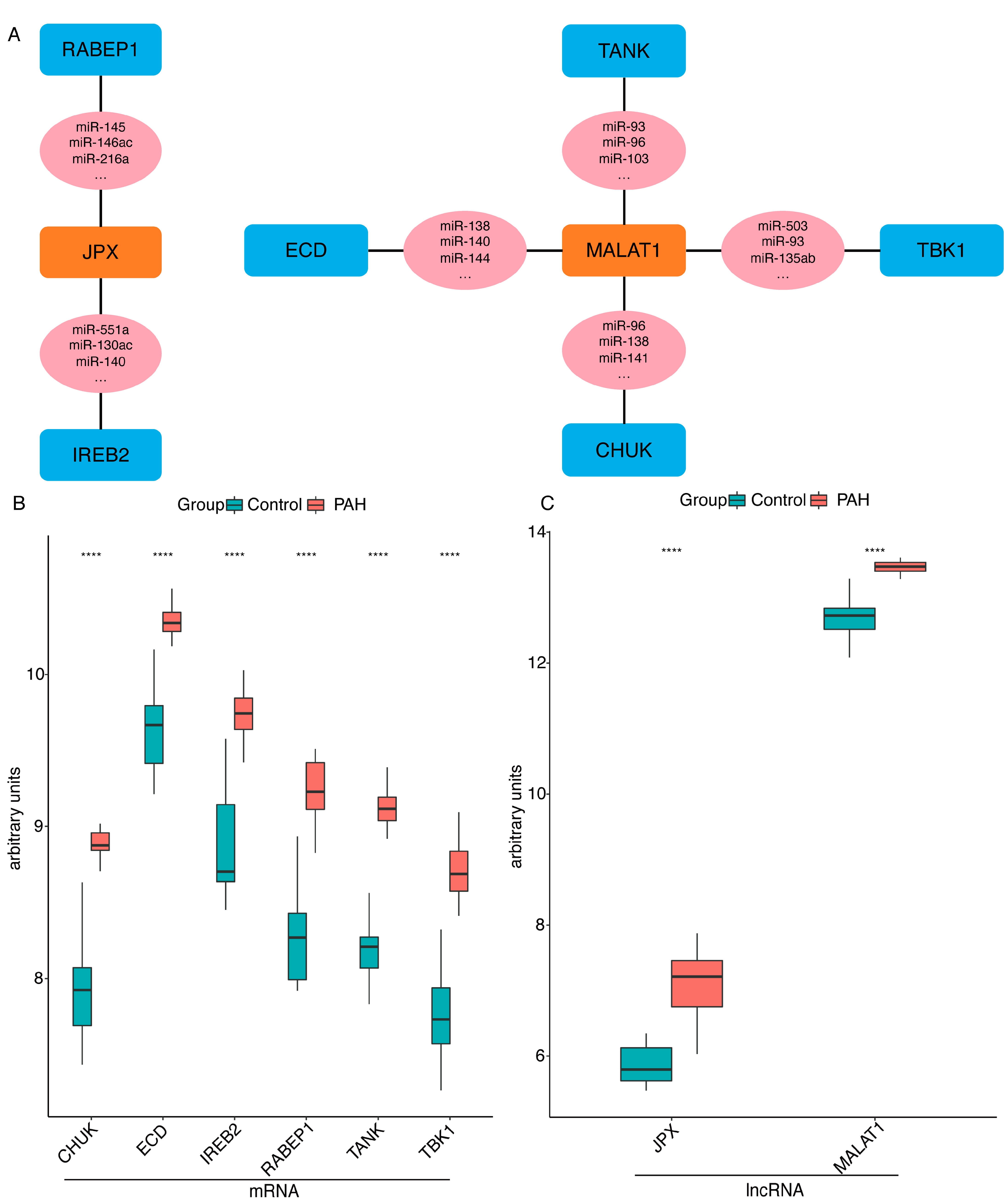
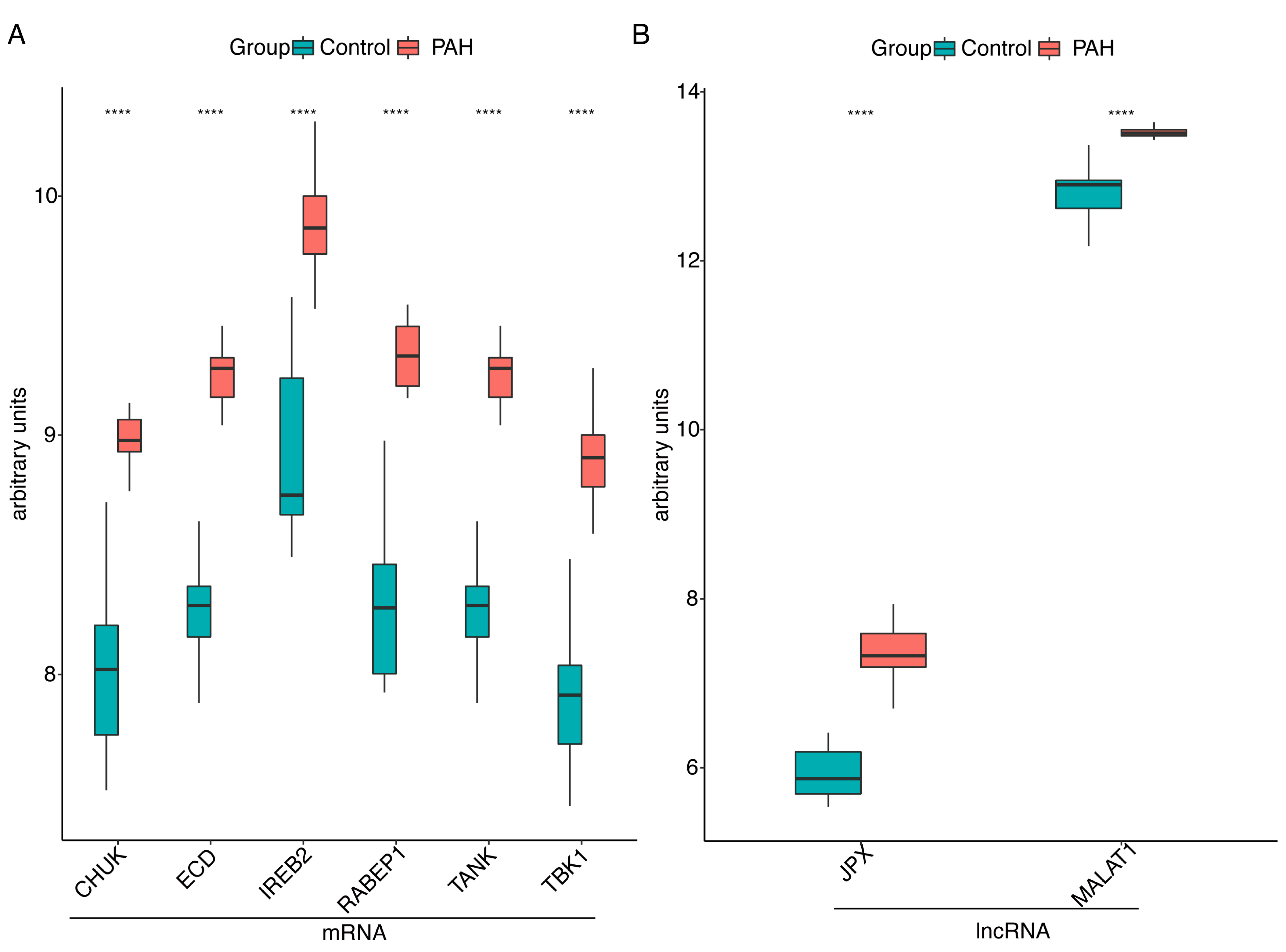
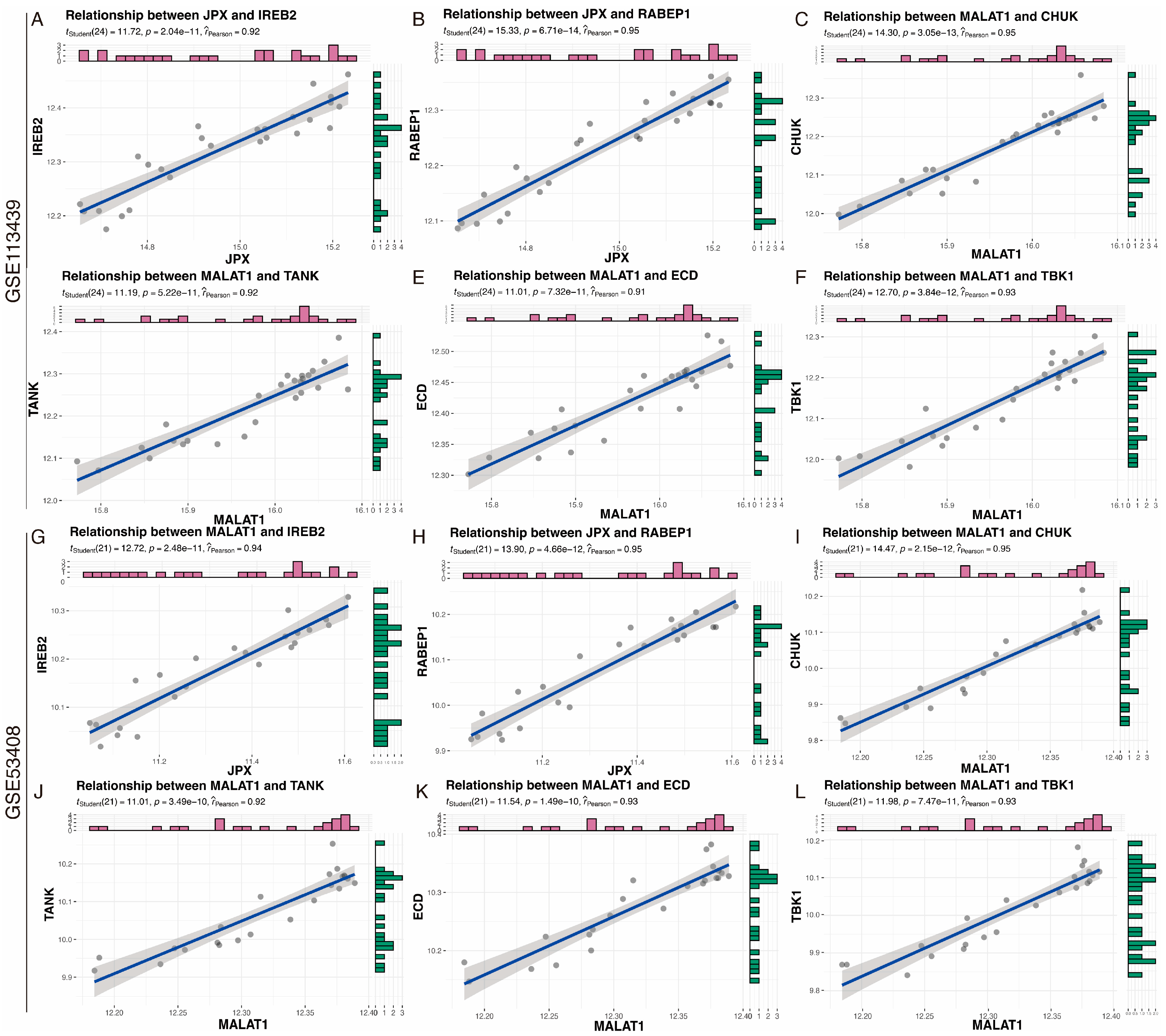
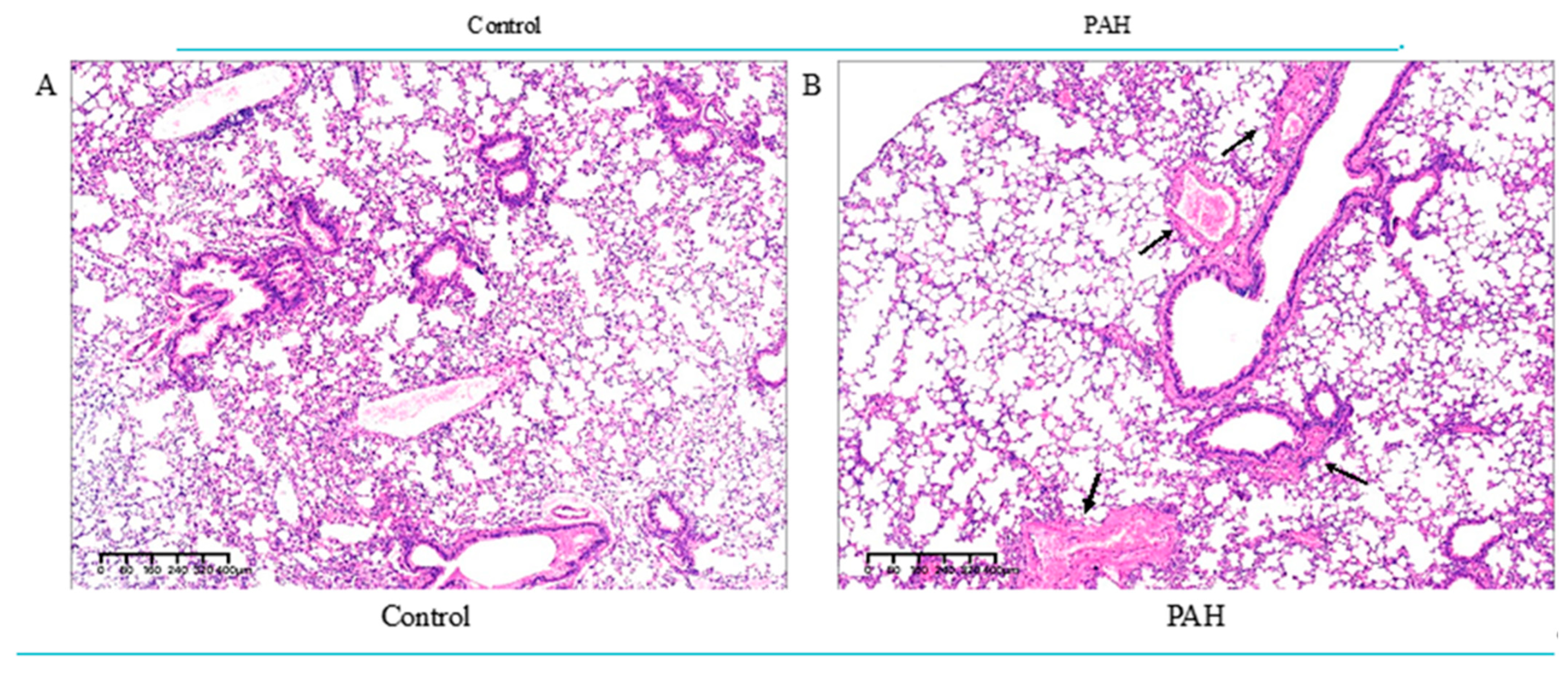
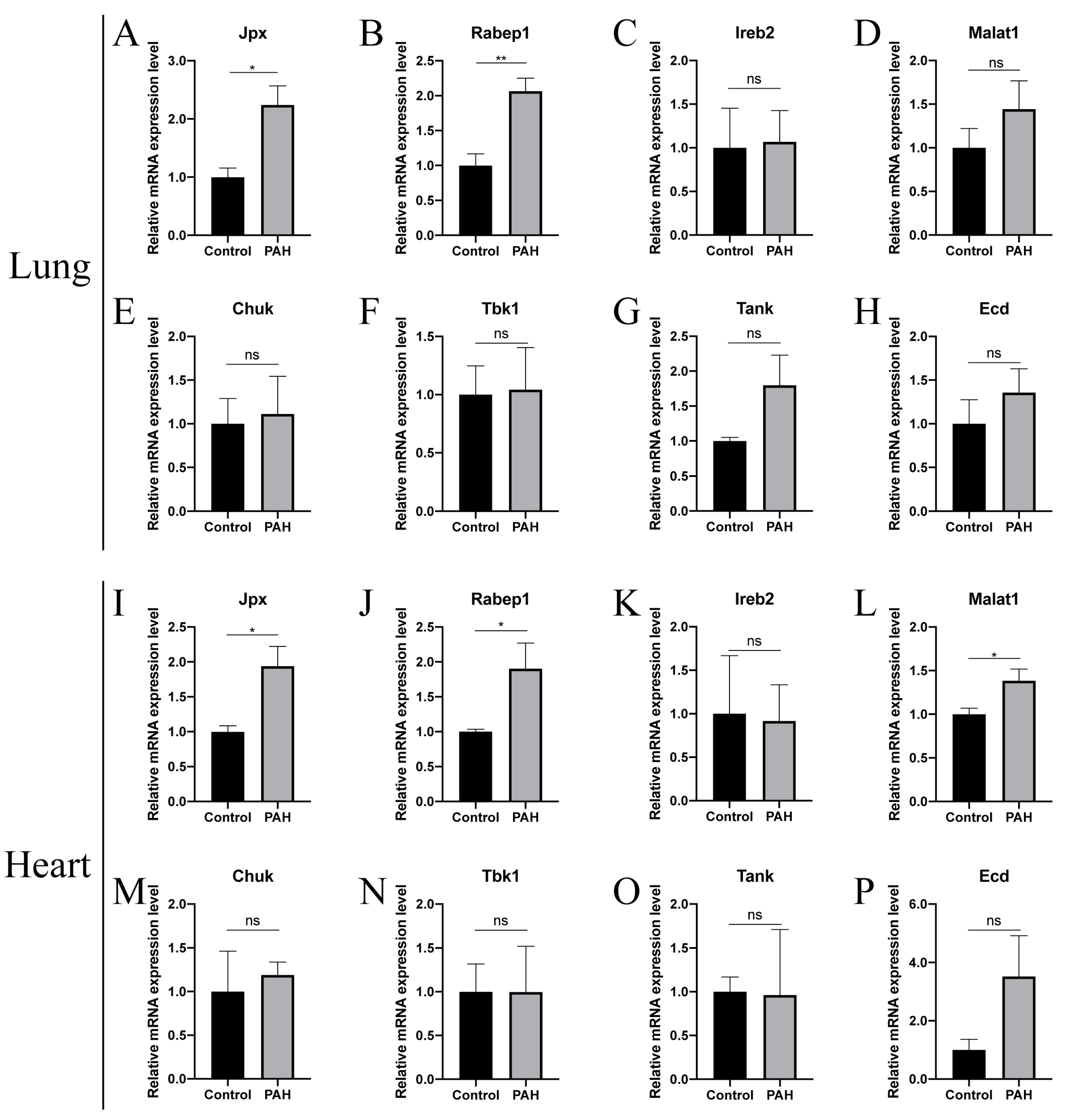
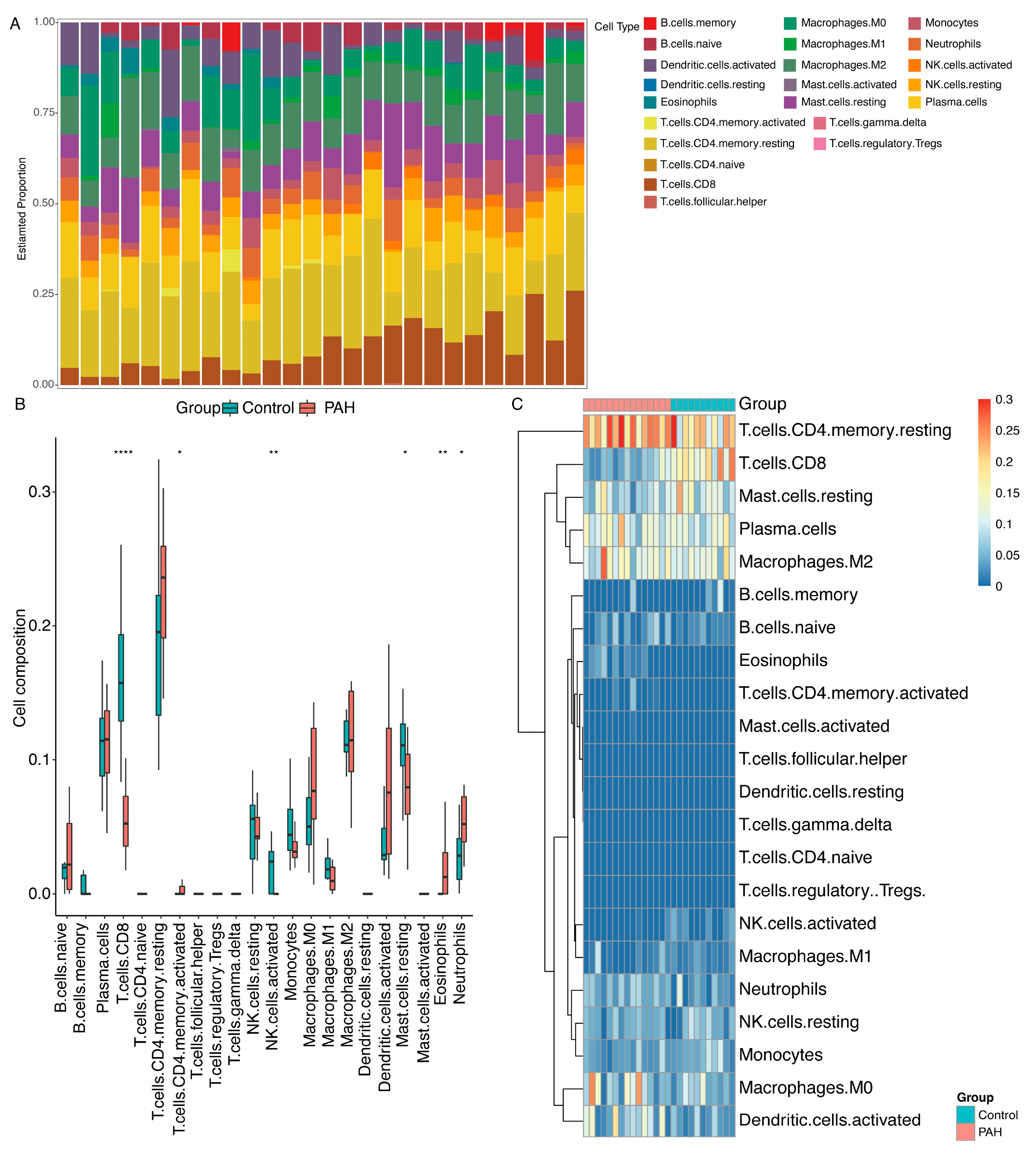
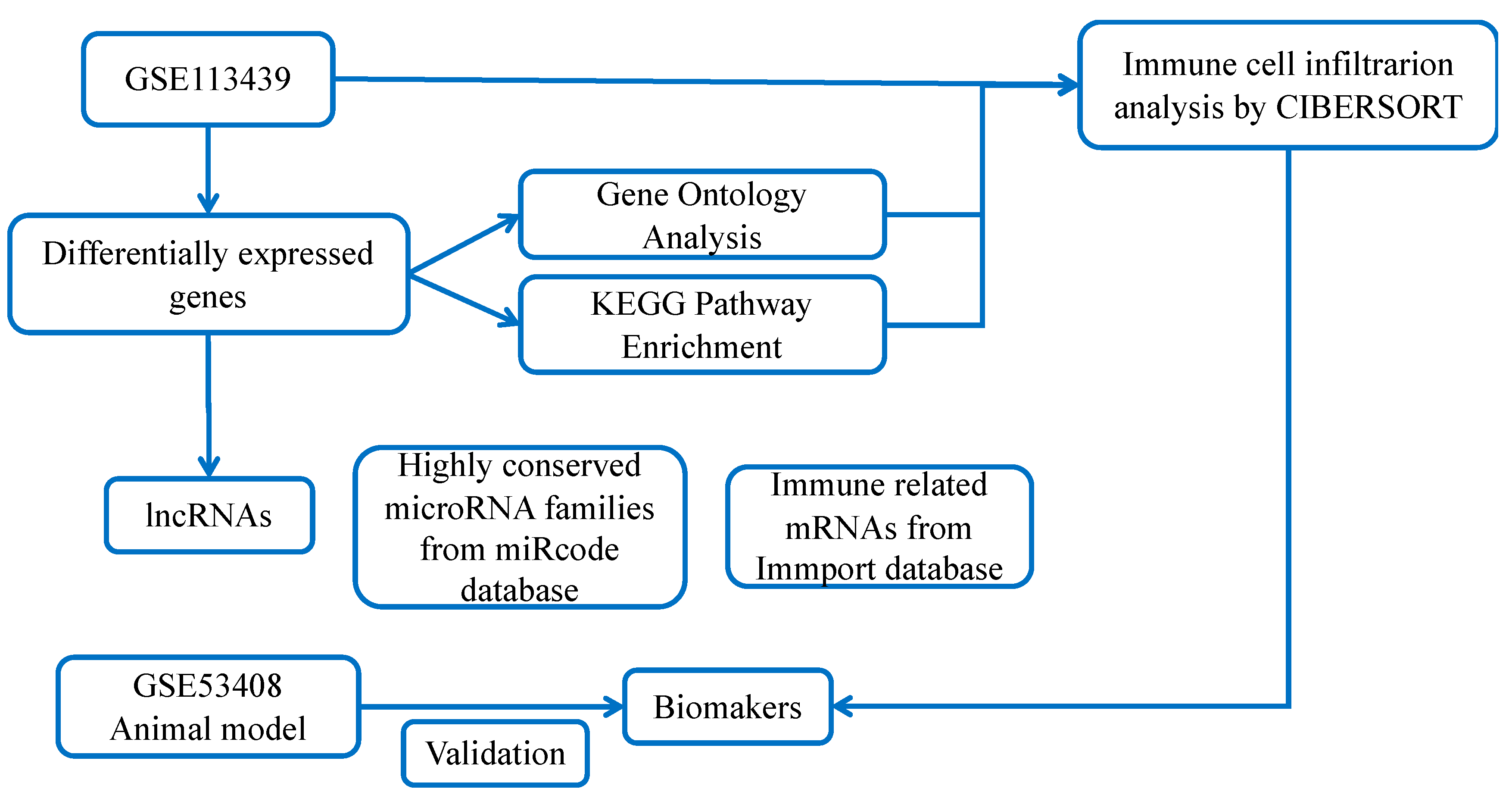
| Immune-Related lncRNA | Immune-Related mRNA | Correlation Co-Efficiency |
|---|---|---|
| JPX | RABEP1 | 0.952570119 |
| MALAT1 | CHUK | 0.946039227 |
| SND1-IT1 | RXRB | −0.943270822 |
| MALAT1 | MAPK3 | −0.937237966 |
| SND1-IT1 | MAPK3 | −0.933509908 |
| MALAT1 | TBK1 | 0.932978885 |
| JPX | ICAM2 | −0.931467245 |
| MALAT1 | TNFRSF14 | −0.931453188 |
| JPX | IREB2 | 0.92261343 |
| JPX | GDF10 | −0.921912199 |
| SND1-IT1 | CTF1 | −0.921173014 |
| SND1-IT1 | ECD | 0.920122958 |
| SND1-IT1 | HSPA5 | 0.920074041 |
| MALAT1 | NR2F1 | −0.919527008 |
| MALAT1 | TANK | 0.916072818 |
| MALAT1 | CTF1 | −0.91363069 |
| MALAT1 | ECD | 0.913586674 |
| MALAT1 | CMTM8 | −0.910914511 |
Publisher’s Note: MDPI stays neutral with regard to jurisdictional claims in published maps and institutional affiliations. |
© 2022 by the authors. Licensee MDPI, Basel, Switzerland. This article is an open access article distributed under the terms and conditions of the Creative Commons Attribution (CC BY) license (https://creativecommons.org/licenses/by/4.0/).
Share and Cite
Gong, Q.; Hu, Z.; Jin, Q.; Yan, Y.; Liu, Y.; He, J.; Zhuang, L.; Wang, H. Identification of JPX-RABEP1 Pair as an Immune-Related Biomarker and Therapeutic Target in Pulmonary Arterial Hypertension by Bioinformatics and Experimental Analyses. Int. J. Mol. Sci. 2022, 23, 15559. https://doi.org/10.3390/ijms232415559
Gong Q, Hu Z, Jin Q, Yan Y, Liu Y, He J, Zhuang L, Wang H. Identification of JPX-RABEP1 Pair as an Immune-Related Biomarker and Therapeutic Target in Pulmonary Arterial Hypertension by Bioinformatics and Experimental Analyses. International Journal of Molecular Sciences. 2022; 23(24):15559. https://doi.org/10.3390/ijms232415559
Chicago/Turabian StyleGong, Qian, Zhewei Hu, Qiao Jin, Yan Yan, Yan Liu, Jin He, Lenan Zhuang, and Huanan Wang. 2022. "Identification of JPX-RABEP1 Pair as an Immune-Related Biomarker and Therapeutic Target in Pulmonary Arterial Hypertension by Bioinformatics and Experimental Analyses" International Journal of Molecular Sciences 23, no. 24: 15559. https://doi.org/10.3390/ijms232415559
APA StyleGong, Q., Hu, Z., Jin, Q., Yan, Y., Liu, Y., He, J., Zhuang, L., & Wang, H. (2022). Identification of JPX-RABEP1 Pair as an Immune-Related Biomarker and Therapeutic Target in Pulmonary Arterial Hypertension by Bioinformatics and Experimental Analyses. International Journal of Molecular Sciences, 23(24), 15559. https://doi.org/10.3390/ijms232415559








